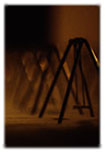

Unless copyright restrictions on the reproduction of visual texts are relaxed,
there will be no significant growth of the kinds of intertextual reading which include
wide-scale knowledge of visual imagery. Literature has been seen as an
élitist domain because of the often elaborate codings used within its
structures, but at least literature, and writing in general, are accessible to
people who can read.
In contrast, however, visual art is a field that is
delimited to varying degrees by laws that govern property ownership, copyright
of reproduction, and the moral rights of the artists who create its
'materiality'. There are various economies operating throughout the territory
of the art world, and as well as these economies are the politics governing
both the worth (in every sense) of art-works, and the various ways in which art
will be viewed.
It is often difficult to find a way through the maze of
arts bureaucracies. To publish any document which seeks to use visual language
as much as its verbal counterpart -- to procure (and pay for) permission to
reproduce images not belonging to the assembler, and to publish them in
colour -- is almost always an impossible (and certainly an economically unviable)
proposition.
Why is it, that images occupy such an exclusive position
in this society; that there are invisible, but powerful forces seeking to
prevent experimentation with, and exploration of, the language of visual
images. In order to read inter-imagically, reproductions of visual images need
to be available to the general community. Many artists' works, for instance,
have never been reproduced in colour, and some are not likely to be, while
these works remain in often highly inaccessible places: whether private or
public.
There are various web sites displaying the works of artists, but private and
bureaucratic ownership images often makes viewing (or reproducing) those
images, either almost, or completely, impossible. Certainly, many works are
currently inaccessible to the general population.
Reading intertextually is a creative process, and it is possible to imagine
many works, but seeing a text, even if only in reproduction, is obviously
preferable to not being able to see the text at all. Intertextuality relies on
there being texts with which to intertext. With many texts becoming
web-oriented, a textual realm might have arrived, where reading intertextually
and inter-imagically can take place unhindered (by the constraints often
implicit in obtaining and reading material texts). Many institutions (such as
the Australian National Gallery) are re-thinking the 'wisdom' of making their
works available in a medium that makes it easy to down-load those images.1
Various government institutions, and other
web-controlling bodies, are becoming increasingly aware of the potential
economics of the web. The availability of many texts, including even written
texts, however, may decrease rather than increase with increased use of the web
as a textual medium. This will be especially so where texts are available only
to readers with access to the, as yet still very privileged, textual space of
the world wide web.
Copyright continues to restrict the practice of inter-imagic
reading; and whereas the world wide web might alleviate this situation,
it seems that the economics that surround the world of visual art will
continue to operate, even though an ideal (albeit privileged) inter-imagic
material textuality is now in operation. I understand that the estate
of Sidney Nolan may be entitled to payment if I were to profit financially
by reproducing Kelly, 1946 on this site. As it is, however, I
want to draw that image into an intertextual assemblage in order to
explore how it is that reading inter-imagically might be described.
The image entitled screen, 1998 is one way of depicting the kind
of reading practice I hope to see enter more
fully into discussions of art/web/(inter)textual theories.
This piece is part of
a longer work on copyright written by Diane Caney in 1998. If you would
like to access the complete work, see Caney's website: http://www.overthere.
com.au/copy/
References and Notes
Todd, Stephen. 'Left Bank on disc.' Weekend Australian: Syte (Nov. 30-Dec 1 1996): 6.
One has to be an academician -- deader
than a fossil -- to complete a dictionary in any language
whatsoever. Weak people would begin to think about the first
letter of the alphabet, and they would soon rush into madness!
Rimbaud
access denied
© all rights reserved
1. Gyongyi Smee, of the ANG, says that the ANG has delayed its virtual project because it fears unauthorised down-loading of the images provided in that space (in conversation with me in July, 1996). Stephen Todd reports, however, that both the Musée d'Orsay and the Louvre have just released CD-ROMs, and also have web sites. Clemence Berg, the multimedia co-ordinator for the Réunion des Musées Nationaux (RMN), says, '[I]f we didn't do it, someone else would ... Technically ... the art works are public property, and anyone can easily get hold of images of the Mona Lisa and whip up a bit of text to go with it' (Todd 6). Todd reports that the CD-ROM Musée d'Orsay Virtual Visit (which accompanies exhibitions of its works), 'takes you on an interactive tour of the museum using Quicktime VR to create 360-degree images of galleries spread out over three floors. Click on any of two hundred art-works, and you call up detailed files on the artist's life and times' (6). The 'virtual visit' is designed to accompany the 'hard-copy' exhibition of the museums' works. ('Paris in the Late 19th Century' was exhibited at the ANG in December 1996-January 1997.)